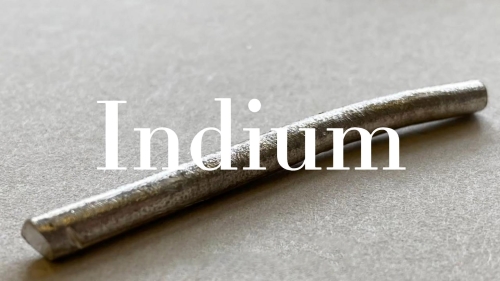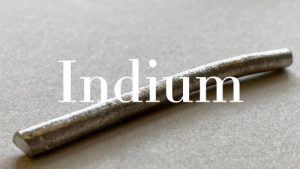
Indium is a lesser-known but incredibly valuable element. This metal, with its unique properties, has become indispensable in the modern world. Let’s discover interesting facts, including when did we discover Indium? Can we chew Indium metal? Why Indium can scream? Here are 10 fascinating facts about Indium metal and Indium Tin Oxide (ITO).

Indium was discovered in 1863 by German chemists Ferdinand Reich and Hieronymous Theodor Richter while they were conducting spectroscopic studies on zinc ores at the Freiberg School of Mines. Initially searching for traces of thallium, they instead observed a distinct indigo-blue spectral line, indicating the presence of a new element. They named this element indium after the indigo color observed in its spectrum, marking the beginning of its exploration and eventual utilization in various technological and industrial applications.
Related reading: 10 Important Uses Of Indium
Indium is relatively rare, with its primary source being zinc ores. It is also obtained as a byproduct of processing other metals, such as lead and copper. This rarity makes In a valuable commodity. The global demand for it has been steadily increasing, driven by its essential role in modern technology, particularly in the production of ITO for electronic displays and solar panels.
Indium is an exceptionally soft and malleable metal, so soft that it can be easily cut with a knife and even bitten without much effort. Its high malleability and ductility mean it can be rolled into thin sheets and drawn into wires without breaking. These properties make In highly useful in various applications requiring flexibility and pliability. For instance, in electronics manufacturing, indium’s softness allows it to form effective seals and gaskets, essential for maintaining the integrity of devices.
In is known to “scream” when bent, a phenomenon similar to the “cry” of tin. This unique sound is produced by the crystal twinning in the metal, where crystals within the metal deform and realign under stress. This audible “cry” is not only an intriguing characteristic but also a useful indicator of the metal’s properties and behavior under stress.
Indium comes with an exceptionally low melting point of about 156.6°C (313.9°F). This property makes it ideal for applications that require low-temperature soldering. Indium-based solders are widely used in the electronics industry because they reduce the risk of thermal damage to sensitive components. Moreover, In’s ability to form alloys with other metals enhances its utility in creating materials with specific melting points and properties tailored to various industrial needs.
Despite having relatively low thermal conductivity compared to metals like copper and aluminum, In is an excellent thermal interface material. Its ability to conform to surfaces and fill microscopic gaps improves heat transfer between components. This makes indium foil and In-based compounds highly effective in managing heat in electronic devices, ensuring optimal performance and longevity of components such as CPUs and GPUs.
Indium remains ductile at extremely low temperatures, making it ideal for use in cryogenic applications. In environments where materials are subjected to temperatures close to absolute zero, indium’s flexibility and reliability are unmatched. It is often used to create seals and gaskets in liquid helium and liquid hydrogen systems, where maintaining a vacuum and preventing leaks are critical for efficient operation.
The most significant application of In is in the production of indium tin oxide (ITO). ITO is a transparent conductive oxide that is widely used in touchscreens, flat-panel displays, and solar cells. Its unique combination of electrical conductivity and optical transparency makes it an ideal material for these applications. In touchscreens, ITO enables the responsive touch capability that users have come to expect in smartphones, tablets, and other devices.
Indium has several radioactive isotopes, with indium-111 being particularly noteworthy for its use in medical diagnostics. Indium-111 is used in nuclear medicine for imaging and tracing, allowing doctors to diagnose and monitor various conditions. It helps in identifying infections, tumors, and other abnormalities within the body, providing critical information for effective treatment.
In is used to create a variety of low-melting-point alloys, such as Field’s metal, which melts at around 62°C (144°F). These alloys are used in applications like fire suppression systems and safety devices. The low melting point allows these materials to act quickly in emergency situations, providing an added layer of protection and safety.
Indium’s unique properties have made it a cornerstone of modern technology. From its role as a thermal interface material to its crucial function in touchscreens through ITO, indium’s applications are diverse and impactful. As demand for advanced technology continues to grow, so too will the importance of indium. For more information, please check Advanced Refractory Metals (ARM).
Copyright © 1994-2024 Advanced Refractory Metals owned by Oceania International LLC, All Rights Reserved.